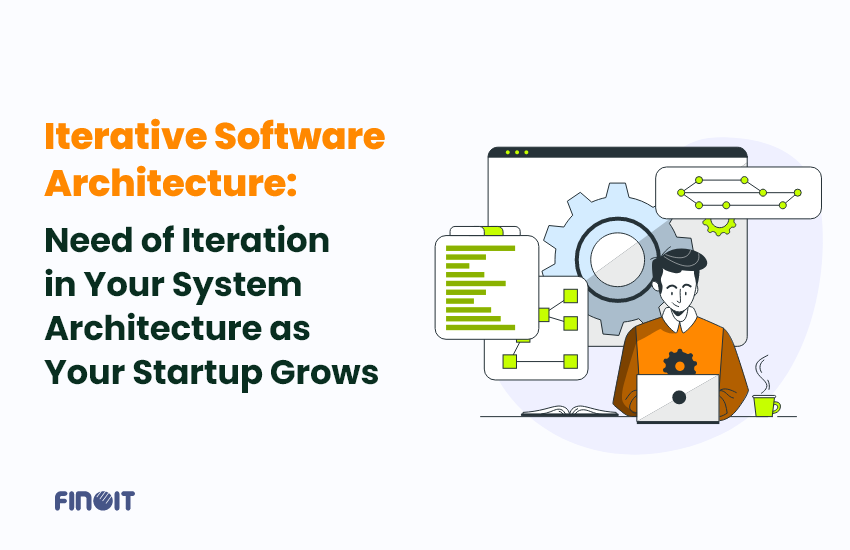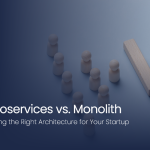Iterative Software Architecture: Need of Iteration in Your System Architecture as Your Startup Grows

We all know Darwin’s theory of ‘Survival of the fittest.’ A theory that conceptualizes that we have to adapt as we learn and grow. Growing your business involves a similar cycle of ideation, designing, testing, and refining for software development. A continuous process that involves learning, iterating, and evolving to the changing business needs and technological advancements.
The current market scenario is highly competitive, with a new digital product being bombarded every day. How do you gain traction in this overcrowded market? Most start-ups look for a foolproof strategy for designing their products. But does such an approach exist? Read on to know more!
Use Iterative Design in Product Development
While laying the Foundation of your startup, you must have come across or even utilized frameworks like Scrum and Rational Unified Process (RUP). These frameworks were early versions of ‘Iterative Programming’ that came into place to fill in the limitations of the waterfall and other stage-gate methods. Later, all these frameworks were unified in the Agile Manifesto to create the most used iterative approach of today – the Agile method.
When you are ideating a product or business with an iterative design process, it means you want to remain flexible to create or refine your idea instantaneously at any phase of your design process. The first step is to ask, ‘What problem will my product solve’? To answer this question, you must research the needs and expectations of your end users.
The next step is to develop your idea into a prototype that can be tested on the market, analyzed, and refined until you meet the set expectations. However, if you want to reap the true benefit of iterative design, you must repeat this loop to match your customer expectations. It is an incessant process; one example is IBM, which began using an iterative model in computer system design in the 1970s but continues to utilize the same approach to date.
Benefits of Iterative Development for Your Business Growth
If you aim to customize software development for your startup, you must periodically assess and iterate your software application to match changing business needs and technological advancements. Here are some reasons in favor of our argument:
Aligns Your Business with the Market Needs:
Businesses evolve over time, and their goals, strategies, and project management requirements change. If you evaluate your product’s system architecture periodically, you can be sure that it supports and aligns with your business’s current and future objectives, ensuring maximum efficiency, competitiveness, and growth. Here are some ways in which iteration aligns your product with the business goals:
Flexibility and Adaptability:
Iterative evolution allows your startup to adapt quickly to changing market conditions, customer preferences, and technological advancements. Continuous iterations on products, services, or processes make your business agile and more responsive to evolving business needs.
Reduced Risk:
Breaking down larger initiatives into smaller, manageable iterations reduces the risk associated with large-scale changes. Hence, you can test, learn, and adjust along the way, minimizing the impact of potential failures or mistakes.
Customer-Centric Approach:
If you follow an iterative design, you can gather feedback from customers or stakeholders early and frequently. Incorporating this feedback in each development phase can ensure that your offerings align closely with customer needs and preferences.
Cost Efficiency:
Iterative approaches can potentially save costs by identifying and addressing issues early in the process. Addressing these issues can bypass expensive rework or overhauls later on.
Also Read: Effective ways for software startups to reduce development costs?
Faster Time-to-Market:
Instead of waiting for a foolproof solution, you can utilize iterative evolution to plan to launch your minimum viable products (MVPs) or incremental updates. A faster time-to-market can greatly help you gain traction in the competitive market.
Alignment with Business Goals:
You can align your iteration approaches with specific business goals or key performance indicators (KPIs), to ensure that your business’s growth process remains focused on delivering tangible value and achieving strategic objectives.
Refines and Adapts Your Product to Technological Advancements:
Technology is in a constant state of flux as new tools, frameworks, and methodologies emerge regularly. Continuous refinement and adaptations of your product’s system architecture will enable you to integrate these advancements seamlessly into your product. Adopting this software architecture best practice, you can leverage new technologies to improve your product’s performance, security, scalability, and user experience. Here are some steps in which it is achieved:
Continuous Learning and Improvement:
Iterative evolution breaks down your processes or product design into smaller, manageable iterations, enabling you to create opportunities for constant learning. Each cycle allows you to gather feedback, analyze results, and implement changes, ensuring your business is always evolving and staying relevant even in the face of technological shifts.
Flexibility to Embrace Change:
An iterative approach lets you make frequent and finer adjustments in your design in place of large, monolithic updates that might be difficult to deploy with the ongoing rapid tech changes. Hence, you can swiftly adopt new technologies or replace existing legacy frameworks without major disruptions to your operations.
Faster Integration of Innovations:
Whether it is for updating software, adopting new tools, or leveraging emerging trends, the iterative process enables you to integrate technology innovations incrementally, ensuring your business a smoother transition and quicker adaptation.
Make Your Business More Scalable and Flexible:
As businesses grow, their systems need to accommodate increased data volumes, user traffic, and functionalities. You can use an iterative approach to identify scalability bottlenecks and make the required refinements to ensure your product is scaling effectively. Moreover, the iterative architecture ensures flexibility, enabling easier integration with new services or changes in customer requirements. Here is how this attribute influences your business:
Scalability Through Incremental Growth:
Instead of attempting large-scale changes in one go, an iterative approach breaks down development into smaller, manageable chunks. Each iteration builds upon the last, allowing for gradual but consistent expansion. This strategy facilitates scalability by ensuring that as your business grows, the foundation remains strong and adaptable.
Refinement and Optimization:
Iterative evolution is not just about growth; it is about refining and optimizing processes or products at each stage. With continuous iteration, you are constantly improving efficiency and effectiveness. Frequent iterative refinement contributes to a scalable framework by identifying and addressing inefficiencies before they become obstacles to your startup’s growth.
Adaptability to Changing Demands:
The iterative approach inherently fosters flexibility. As you evolve in smaller increments, you’re better equipped to respond to changing market conditions, customer needs, or industry trends. This adaptability allows you to pivot swiftly, adjusting strategies or offerings without disrupting the entire business infrastructure.
Reduced Risk in Scaling:
Iterative evolution is incessant in nature; hence it mitigates the risk associated with scaling. Since it does not leap into the unknown, each iteration acts as a test bed, allowing you to assess the impact of changes before implementing them on a larger scale. The one-step-at-a time ensures that scalability does not compromise the stability of your business.
Agile Decision-Making:
Iterative evolution encourages an agile mindset within your business. It enables quicker decision-making processes as smaller changes can be evaluated and adjusted rapidly. Agility in your product design is crucial when scaling, as it allows for swift adjustments based on real-time customer feedback or market shifts.
Enhances the Security Measures of Your Product:
Security threats and vulnerabilities are ever-present. Hence, frequent refinement and adaptation of your product’s architecture help identify potential security risks and implement necessary updates or improvements to safeguard the system and data. Iterative evolution significantly contributes to enhancing the security of your product in various ways like:
Continuous Vulnerability Assessment:
Security measures can be integrated at each stage of your product lifecycle through iterative development. As the implementation will be gradual, therefore, you can continuously assess and identify vulnerabilities in your product, addressing them incrementally can strengthen your product’s security against potential threats.
Regular Updates and Patches:
Through iterative evolution, updates and patches are regularly released which ensures that the product security is constantly improving and adapting to emerging threats. Thus, your product design will remain proactive in addressing security issues and deploying fixes promptly.
Adaptive Security Measures:
The iterative approach allows for the adaptation of security measures based on changing threat landscapes. As new security risks arise, iterations enable you to implement necessary changes swiftly, enhancing your product’s resilience against evolving threats.
Iterative Testing and Feedback:
Iterative evolution provides you the opportunity for rigorous testing and feedback collection. This includes security testing by experts or ethical hackers. By incorporating their feedback into each iteration, you can identify and rectify security flaws early in the development cycle, preventing them from becoming major vulnerabilities.
User-Centric Security:
You can gather feedback from users throughout the iteration process that allows you to understand their security concerns and preferences. With the gathered insight, you can customize security features that align with your user needs.
Compliance and Standards Adherence:
Iterative evolution facilitates adherence to security standards and compliance requirements. If you successfully integrate security measures into each iteration, it ensures your product aligns with industry standards and regulations.
Initiates Incremental Development To Enhance User Experience
Ensuring a successful startup involves more than just a great idea; it requires a solid technical foundation. The importance of system architecture for startup success cannot be overstated. As user expectations evolve, your system architecture should adapt to meet their needs. By adopting new technologies gradually, you can enhance your customer’s user experience and offer them better performance, responsiveness, and usability. Iterative evolution is a game-changer when it comes to enhancing user experience in several impactful ways as follows:
Continuous Refinement:
Through iterative cycles, you are constantly refining your product based on user feedback and data insights. This iterative process allows you to make incremental improvements, resulting in a product that becomes increasingly intuitive, efficient, and user-friendly over time.
User-Centric Design:
Iterative evolution often involves gathering user feedback at each stage. This user-centric approach ensures that your product is designed and developed with the user in mind. Integrating user preferences, behaviors, and needs into iterations creates a more tailored and satisfying user experience.
Swift Response to Feedback:
Iterative cycles allow for quick responses to user feedback. You can implement changes or features based on user suggestions or pain points rapidly, showing users that you value their input. As you become more agile, you can foster a sense of involvement and responsiveness, enhancing your user’s overall satisfaction.
Testing and Validation:
You can continuously test and validate features or design elements of your product with an iterative approach. Hence identifying and rectifying usability issues early in the process becomes easy leading to a more polished and user-friendly end product.
Reduced Friction Points:
As iterations progress, you gradually iron out any friction points in the user journey. Each cycle brings enhancements that streamline processes, improve navigation, and simplify interactions, resulting in a smoother and more enjoyable user experience.
Personalization and Adaptability:
An Iterative development process allows you to integrate personalized features or adaptability based on your user behavior. This tailored approach enhances user satisfaction by providing a more customized and relevant user experience.
Conclusion
A common observation that we see while working with most of our clients, is that we have to encounter a trade-off between time, budget, and functionality. In most scenarios, therefore we have to scale one of these areas. However, the issue is resolved as we adopt Iterative Development. The approach has been hailed as a promising solution for ambitious projects that have limited budgets. This method involves quickly releasing functional software to the market and gradually improving it over time.
However, it requires a highly skilled development team to steer the project away from potential risks and prevent it from stalling. Finoit has certified professionals who can help you refine and adapt your system architecture with Iterative development as your business grows. To know how, schedule a demo today!

